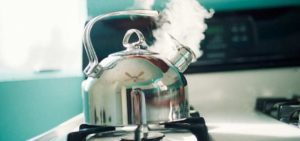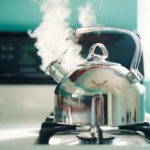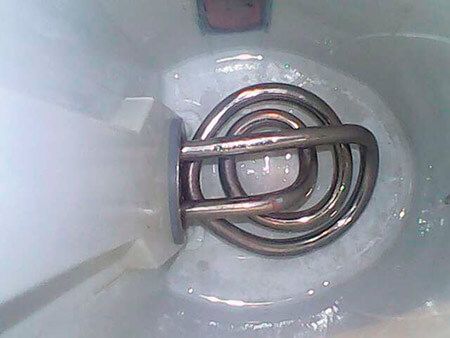At what temperature does water boil in a kettle?
 The boiling process involves the transition of a liquid substance to a gaseous state. The difference between evaporation is that it happens in conjunction with certain indicators, which include not only temperature indicators, but also pressure indicators. The speed of boiling is entirely related to the molecules, which, when heated, begin to collide with each other more often. If we take ordinary conditions, then the boiling point is considered to be a heating of 100 degrees Celsius, but in fact this is a range of values that depends both on the liquid itself, as well as the pressure outside and inside the water. To summarize, this range has values from 70, on a very high mountain, to 110, if it is closer to sea level.
The boiling process involves the transition of a liquid substance to a gaseous state. The difference between evaporation is that it happens in conjunction with certain indicators, which include not only temperature indicators, but also pressure indicators. The speed of boiling is entirely related to the molecules, which, when heated, begin to collide with each other more often. If we take ordinary conditions, then the boiling point is considered to be a heating of 100 degrees Celsius, but in fact this is a range of values that depends both on the liquid itself, as well as the pressure outside and inside the water. To summarize, this range has values from 70, on a very high mountain, to 110, if it is closer to sea level.
The content of the article
Steam temperature of boiling water in a kettle
Steam is a liquid, only its state turns into a gaseous form. When interacting with air, it, like other gaseous substances, can exert pressure on it. During vaporization, the temperature of the vapor and liquid will be constant until the liquid is evaporated. This happens due to the fact that all the temperature is spent on the formation of steam. This situation promotes the formation of dry saturated steam.
It is important to know! When a liquid boils, the steam has identical degrees to it. Steam hotter than the liquid itself can be obtained only with the use of special devices. The degrees required to boil an ordinary liquid are 100 degrees Celsius.
At what temperature does salt water boil?

Bring salted water to a boil, perhaps only at higher temperatures than in the case of ordinary water. Salt water contains a set of ions that fill the spatial gaps of water molecules. Because of this, hydration occurs when salt ions combine with liquid molecules. Since after hydration the bond between molecules becomes noticeably stronger, the vaporization process takes longer.
Due to heating, salt water constantly loses molecules, so their collisions will be much less frequent. It will take longer to boil than fresh water. The temperature at which you can turn salt water into boiling water can be, on average, 10 degrees Celsius higher than normal.
Boiling degree of distilled water
The distilled form is a purified liquid that contains virtually no impurities. Typically, it is intended for technical, medical and research applications.
Attention! Eating it and cooking food with it is strictly not recommended.
Water is made using special distillation equipment, where fresh water is evaporated and steam is condensed. At the end of distillation, impurities will remain outside the liquid.
The distilled type boils in the same way as fresh water from tap water - 100 degrees Celsius.There is a slight difference that the distilled liquid will come to a boil faster, but this difference is quite insignificant.
How does pressure affect the boiling process of water?
 Pressure makes a significant difference for the boiling of a liquid. In this case, atmospheric pressure and pressure inside the water play a role. For example, if you put water on fire at a high altitude, then 70 degrees Celsius will be enough to boil. In the mountains, cooking poses certain difficulties. This takes longer because the boiling water will not be hot enough. For example, an attempt to cook a boiled egg will end in failure, not to mention boiled meat, which requires good heat treatment.
Pressure makes a significant difference for the boiling of a liquid. In this case, atmospheric pressure and pressure inside the water play a role. For example, if you put water on fire at a high altitude, then 70 degrees Celsius will be enough to boil. In the mountains, cooking poses certain difficulties. This takes longer because the boiling water will not be hot enough. For example, an attempt to cook a boiled egg will end in failure, not to mention boiled meat, which requires good heat treatment.
Important! You should not eat anything that has not been heat-treated or well-cooked. Especially when it comes to hiking and other outings in nature. You need to foresee such nuances in advance and insure yourself against possible surprises.
Being near the sea, the boiling point will always be 100 degrees. As you climb the mountains, the temperature for boiling will drop by 1 degree for every 300 meters you travel up. Therefore, residents whose homes are located at elevated locations are advised to use autoclaves to boil liquids to make them hotter.
Attention! Employees of medical institutions and laboratories must know this information.
After all, it is known that in order to sterilize products and devices, a temperature of 100 degrees and above is required. Otherwise, the instrument and other devices will not be sterile, which can subsequently lead to a lot of complications.
It is known that the highest degree of water has not yet been discovered.This is a consequence of the fact that it can grow until there is a limit on atmospheric pressure, or rather, its growth. Steam turbines heat water up to 400 degrees, while it does not boil, and the pressure is maintained at 30-40 atmospheres.






Of course, it’s a personal matter, but you need to evaluate and weigh all the pros and cons. Moreover, if you are not in the mood, you should not rush into choosing something that may not be suitable for you.